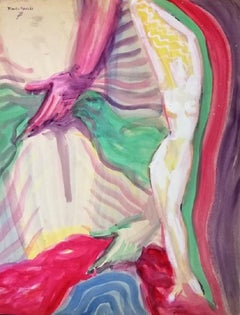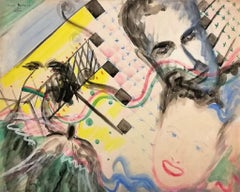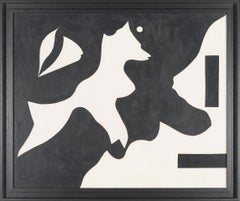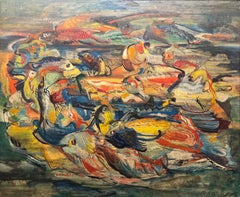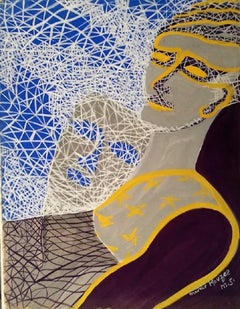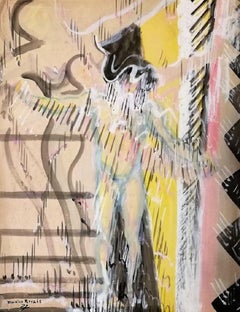Maurice Rouzée Abstract Paintings
Maurice Rouzée was a French painter, designer and artist who worked especially during the first half of the 20th century. He was one of the students of Jean Cocteau. He realized many sets for the Opéra National de Paris and spent time with Cubist and Abstractionist artists.
to
2
Overall Width
to
Overall Height
to
2
1
1
2
1
1
2
2
6
664
615
458
342
Artist: Maurice Rouzée
The Body - Maurice Rouzée - 1940s - Tempera
By Maurice Rouzée
Located in Roma, IT
The Body is an original artwork realized by Maurice Rouzée in the 1940s. Hand-signed by the artist on the upper left margin. Good conditions.
The artw...
Category
1940s Modern Maurice Rouzée Abstract Paintings
Materials
Tempera
The actors
By Maurice Rouzée
Located in Roma, IT
The actors is an original artwork realized by Maurice Rouzée in the 1950's. Tempera on paper; signed by the artist on the upper left margin. Very good condit...
Category
1950s Modern Maurice Rouzée Abstract Paintings
Materials
Tempera
Related Items
" Le Chien à la Lune. "
By André Verdet
Located in CANNES, FR
André Verdet ( 1913 - 2004 ) . Artiste français né à Nice (alpes maritimes ) mort à Saint Paul de Vence .
poète , peintre , sculpteur , céramiste , mus...
Category
1960s Modern Maurice Rouzée Abstract Paintings
Materials
Casein
"Piscatory" Abraham P. Hankins, Modernist Composition of Fish, Abstracted Nature
Located in New York, NY
Abraham P. Hankins
Piscatory, 1941
Signed and dated lower center
Tempera on panel
24 x 30 inches
Provenance
Private Collection, New York
Alexandra Avlonitis, New York (acquired from...
Category
1940s American Modern Maurice Rouzée Abstract Paintings
Materials
Tempera, Panel
Modernist Abstract Bull
By Dick Crispo
Located in Soquel, CA
Unique modernist depiction of an abstracted bull by California artist Dick Crispo (American, b.1945), 1981. The earthtoned animal is outlined in bold strokes of black, and is rendered in an interesting fractured geometric style evocative of cubism's handling of perspective.
Signed and dated lower left "D. Crispo '81", and on label on verso.
Presented in a dark copper metal frame.
Image size; 22.5"H x 28.75"L.
An award winning artist, Crispo has studied at the Carmel Art Institute under John Cunningham and Sam Colburn...
Category
1980s American Modern Maurice Rouzée Abstract Paintings
Materials
Tempera
Le Printemps gris
Located in PARIS, FR
Jacqueline Pavlowsky was born in 1921 in Vincennes to Russian and Polish Jewish parents who had immigrated to France. After the war, she started her studies of chemistry, while at th...
Category
1970s Abstract Maurice Rouzée Abstract Paintings
Materials
Canvas, Tempera
Untitled Abstraction-008 casein tempera on board by Vaclav Vytlacil
By Vaclav Vytlacil
Located in Hudson, NY
Signed and dated "Vytlacil 38" lower left, and signed and dated verso.
Provenance: Estate of the artist #1602; Martin Diamond Fine Art
About this artist: Born in 1892 to Czechoslov...
Category
1930s Abstract Expressionist Maurice Rouzée Abstract Paintings
Materials
Tempera, Casein, Board
What You All Want ??? - Contemporary Figurative Painting, Polish Young Art
Located in Salzburg, AT
Kasia Mazur is a very young artist, she is still studying painting at the Academy of Fine Arts in Gdansk, where she also lives. She has already had exhibit...
Category
2010s Contemporary Maurice Rouzée Abstract Paintings
Materials
Cotton Canvas, Oil, Acrylic, Tempera
$924
H 39.38 in W 28.75 in D 0.79 in
UN Poster Design American Scene Mid 20th Century Modernism WPA World Peace
By Jo Cain
Located in New York, NY
UN Poster Design American Scene Mid 20th Century Modernism WPA World Peace
Jo Cain (1904 – 2003)
We Are All Members of the Human Race: UN Poster Proposal
21 x...
Category
1940s American Modern Maurice Rouzée Abstract Paintings
Materials
Egg Tempera, Board
$29,500
H 30 in W 25 in D 2 in
The Magician oil and tempera painting by Julio de Diego
By Julio de Diego
Located in Hudson, NY
Julio De Diego’s Atomic Series paintings made an extraordinary statement regarding the shock and fear that accompanied the dawn of the nuclear age. In the artist’s own words, “Scientists were working secretly to develop formidable powers taken from the mysterious depths of the earth - with the power to make the earth useless! Then, the EXPLOSION! . . . we entered the Atomic Age, and from there the neo-Atomic war begins. Explosions fell everywhere and man kept on fighting, discovering he could fight without flesh.”
To execute these works, De Diego developed a technique of using tempera underpainting before applying layer upon layer of pigmented oil glazes. The result is paintings with surfaces which were described as “bonelike” in quality. The forms seem to float freely, creating a three-dimensional visual effect. In the 1954 book The Modern Renaissance in American Art, author Ralph Pearson summarizes the series as “a fantastic interpretation of a weighty theme. Perhaps it is well to let fantasy and irony appear to lighten the devastating impact. By inverse action, they may in fact increase its weight.”
Exhibited
1964 Marion Koogler McNay Art Institute, San Antonio, Texas
This work retains its original frame which measures 54" x 42" x 2"
About this artist: Julio De Diego crafted a formidable persona within the artistic developments and political struggles of his time. The artist characterized his own work as “lyrical,” explaining, “through the years, the surrealists, the social-conscious painters and the others tried to adopt me, but I went my own way, good, bad or indifferent.” [1] His independence manifested early in life when de Diego left his parent’s home in Madrid, Spain, in adolescence following his father’s attempts to curtail his artistic aspirations. At the age of fifteen he held his first exhibition, set up within a gambling casino. He managed to acquire an apprenticeship in a studio producing scenery for Madrid’s operas, but moved from behind the curtains to the stage, trying his hand at acting and performing as an extra in the Ballet Russes’ Petrouchka with Nijinsky. He spent several years in the Spanish army, including a six-month stretch in the Rif War of 1920 in Northern Africa. His artistic career pushed ahead as he set off for Paris and became familiar with modernism’s forays into abstraction, surrealism, and cubism.
The artist arrived in the U.S. in 1924 and settled in Chicago two years later. He established himself with a commission for the decoration of two chapels in St. Gregory’s Church. He also worked in fashion illustration, designed magazine covers and developed a popular laundry bag for the Hotel Sherman. De Diego began exhibiting through the Art Institute of Chicago in 1929, and participated in the annual Chicago Artists Exhibitions, Annual American Exhibitions, and International Water Color Exhibitions. He held a solo exhibition at the Art Institute of Chicago in the summer of 1935. Though the artist’s career was advancing, his family life had deteriorated. In 1932 his first marriage dissolved, and the couple’s young daughter Kiriki was sent to live with friend Paul Hoffman.
De Diego continued to develop his artistic vocabulary with a growing interest in Mexican art. He traveled throughout the country acquainting himself with the works of muralists such as Carlos Merida, and also began a collection of small native artifacts...
Category
1940s American Modern Maurice Rouzée Abstract Paintings
Materials
Masonite, Oil, Tempera
No Title
By Pieter de Haard
Located in Dordrecht, NL
Pieter de Haard (Rotterdam 1914-2000)
Category
1940s Abstract Geometric Maurice Rouzée Abstract Paintings
Materials
Tempera, Board
Inevitable Day – Birth of the Atom oil and tempera painting by Julio De Diego
By Julio de Diego
Located in Hudson, NY
Julio De Diego’s Atomic Series paintings made an extraordinary statement regarding the shock and fear that accompanied the dawn of the nuclear age. In the artist’s own words, “Scientists were working secretly to develop formidable powers taken from the mysterious depths of the earth - with the power to make the earth useless! Then, the EXPLOSION! . . . we entered the Atomic Age, and from there the neo-Atomic war begins. Explosions fell everywhere and man kept on fighting, discovering he could fight without flesh.”
To execute these works, De Diego developed a technique of using tempera underpainting before applying layer upon layer of pigmented oil glazes. The result is paintings with surfaces which were described as “bonelike” in quality. The forms seem to float freely, creating a three-dimensional visual effect. In the 1954 book The Modern Renaissance in American Art, author Ralph Pearson summarizes the series as “a fantastic interpretation of a weighty theme. Perhaps it is well to let fantasy and irony appear to lighten the devastating impact. By inverse action, they may in fact increase its weight.”
Bibliography
Art in America, April 1951, p.78
About this artists: Julio De Diego crafted a formidable persona within the artistic developments and political struggles of his time. The artist characterized his own work as “lyrical,” explaining, “through the years, the surrealists, the social-conscious painters and the others tried to adopt me, but I went my own way, good, bad or indifferent.” [1] His independence manifested early in life when de Diego left his parent’s home in Madrid, Spain, in adolescence following his father’s attempts to curtail his artistic aspirations. At the age of fifteen he held his first exhibition, set up within a gambling casino. He managed to acquire an apprenticeship in a studio producing scenery for Madrid’s operas, but moved from behind the curtains to the stage, trying his hand at acting and performing as an extra in the Ballet Russes’ Petrouchka with Nijinsky. He spent several years in the Spanish army, including a six-month stretch in the Rif War of 1920 in Northern Africa. His artistic career pushed ahead as he set off for Paris and became familiar with modernism’s forays into abstraction, surrealism, and cubism.
The artist arrived in the U.S. in 1924 and settled in Chicago two years later. He established himself with a commission for the decoration of two chapels in St. Gregory’s Church. He also worked in fashion illustration, designed magazine covers and developed a popular laundry bag for the Hotel Sherman. De Diego began exhibiting through the Art Institute of Chicago in 1929, and participated in the annual Chicago Artists Exhibitions, Annual American Exhibitions, and International Water Color Exhibitions. He held a solo exhibition at the Art Institute of Chicago in the summer of 1935. Though the artist’s career was advancing, his family life had deteriorated. In 1932 his first marriage dissolved, and the couple’s young daughter Kiriki was sent to live with friend Paul Hoffman.
De Diego continued to develop his artistic vocabulary with a growing interest in Mexican art. He traveled throughout the country acquainting himself with the works of muralists such as Carlos Merida, and also began a collection of small native artifacts...
Category
1940s American Modern Maurice Rouzée Abstract Paintings
Materials
Masonite, Oil, Tempera
American Abstract Contemporary Art by Paul Lorenz - January 02, No. 2
By Paul Lorenz
Located in Paris, IDF
Oil, casein & ink on panel
Paul Lorenz is an American artist born in 1961 who lives & works in Buckeye, AZ, USA. With an education in Bauhaus architecture, fine art, and music compo...
Category
2010s Abstract Maurice Rouzée Abstract Paintings
Materials
Ink, Oil, Casein, Panel
$2,600
H 11 in W 14 in D 1.2 in
Earth Toned Abstract Cityscape
By Emalita Newton Terry
Located in Houston, TX
Earth toned expressionistic cityscape with various colors including blue, red, and green. Framed in black frame with a yellow matte. Signed by the artist i...
Category
Mid-20th Century Abstract Maurice Rouzée Abstract Paintings
Materials
Egg Tempera, Gouache
Previously Available Items
Purple Composition - Maurice Rouzée - 1940s - Tempera
By Maurice Rouzée
Located in Roma, IT
Purple Composition is an original artwork realized by Maurice Rouzée in the 1940s. Hand-signed by the artist on the lower right margin (Maurice Rouzée M...
Category
1940s Modern Maurice Rouzée Abstract Paintings
Materials
Tempera
H 25.6 in W 19.69 in D 0.04 in
Pink Dream - Maurice Rouzée - 1940s - Tempera
By Maurice Rouzée
Located in Roma, IT
Pink Dream is an original artwork realized by Maurice Rouzée in the 1940s. Signed on plate by the artist on the lower left margin. Good conditions.
The...
Category
1940s Modern Maurice Rouzée Abstract Paintings
Materials
Tempera
Lovers - Maurice Rouzée - 1940s - Tempera
By Maurice Rouzée
Located in Roma, IT
Lovers is a beautiful original painting realized by Maurice Rouzée in 1942. Signed and dated on the upper right margin (Maurice Rouzée 11.42). Good cond...
Category
1940s Modern Maurice Rouzée Abstract Paintings
Materials
Tempera
The Dance - Maurice Rouzée - 1940s - Tempera
By Maurice Rouzée
Located in Roma, IT
The Dance is an original artwork realized by Maurice Rouzée in the 1940s. Tempera on paper. Signed by the artist on the lower left. Good conditions exce...
Category
1940s Modern Maurice Rouzée Abstract Paintings
Materials
Tempera
Untitled
By Maurice Rouzée
Located in Roma, IT
Untitled is an original artwork realized by Maurice Rouzée in 1941. Tempera on paper; hand-signed and dated by the artist on the upper left margin ("21 Sept 1941 M.R."). Good conditi...
Category
1940s Modern Maurice Rouzée Abstract Paintings
Materials
Tempera
Embraces
By Maurice Rouzée
Located in Roma, IT
Embraces is an original artwork realized by Maurice Rouzée in the 1940's; tempera on paper. Good conditions.
The artwork represents an abstract composition realized with a combinat...
Category
1950s Modern Maurice Rouzée Abstract Paintings
Materials
Tempera
The Flame - Original Tempera on Paper by Maurice Rouzée - 1950s
By Maurice Rouzée
Located in Roma, IT
The Flame is an original artwork realized by Maurice Rouzée in the 1950's. Tempera on paper; signed on plate on the upper left margin. Very good conditions.
The artwork represents a...
Category
1950s Modern Maurice Rouzée Abstract Paintings
Materials
Tempera
H 24.97 in W 19.38 in D 0.04 in
Blue Masquerade - Original Tempera on Paper by Maurice Rouzée - 1940s
By Maurice Rouzée
Located in Roma, IT
Blue Masquerade is an original artwork realized by Maurice Rouzée in the 1940's. Tempera on paper; signed by the artist on the lower left margin ("Maurice Rouzée M.S."). Very good co...
Category
1950s Modern Maurice Rouzée Abstract Paintings
Materials
Tempera
H 19.22 in W 25.12 in D 0.04 in
Maurice Rouzée abstract paintings for sale on 1stDibs.
Find a wide variety of authentic Maurice Rouzée abstract paintings available for sale on 1stDibs. You can also browse by medium to find art by Maurice Rouzée in paint, tempera and more. Much of the original work by this artist or collective was created during the 20th century and is mostly associated with the modern style. Not every interior allows for large Maurice Rouzée abstract paintings, so small editions measuring 20 inches across are available. Customers who are interested in this artist might also find the work of Rosie Phipps, Erika Baktay, and Abram Krol. Maurice Rouzée abstract paintings prices can differ depending upon medium, time period and other attributes. On 1stDibs, the price for these items starts at $267 and tops out at $446, while the average work can sell for $356.
